ALIEN INVADERS
Tiny but seemingly invincible beetle has killed thousands of trees across SA, millions more at risk
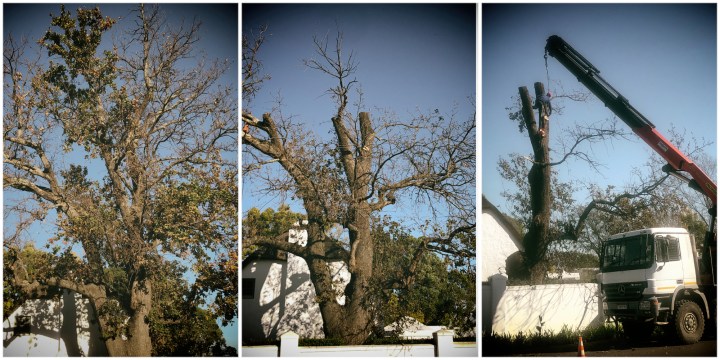
Thousands of urban trees have already been killed and removed as an infestation of the polyphagous shot hole borer beetle, also known as the tree-killing beetle, in the country continues to spread, with 65 million urban trees at risk of dying in cities over the next three decades, unless the situation is controlled.
Since 2017, when the first report was received in South Africa of the polyphagous shot hole borer (PSHB), thousands of trees have died or had to be cut down in urban areas, native forests and more recently in fruit crops.
In Cape Town alone, more than 5,000 trees have been infested, with no known and proven remedies to deal with or eradicate this pest, other than chipping infested trees.
However, biological control measures are being explored with a research group just back from Vietnam where the ambrosia PSHB beetle is thought to be native to South East Asia.
It bores into the sapwood of trees and feeds on a fungus that it cultivates within trees and not the tree itself. It infests and often kills seemingly healthy trees, which should be a concern to all as the invasive insect has a broad range of hosts that it infects.
Speaking at the Western Cape Climate Indaba in March, Guy Midgley, the director of Stellenbosch University’s (SU) School for Climate Studies, cited an alarming statistic: 65 million urban trees were at risk of dying in South African cities over the next three decades unless the situation is controlled.
This could cost the country R275-billion.
Midgley said: “The 65-million-tree estimate is from a paper SU’s Centre for Invasion Biology produced a couple of years ago and represents an upper estimate of possible tree mortality… The School for Climate Studies has [also] raised the link between the PSHB and the climate change implications, in terms of emissions and urban adaptation (trees are used for shading in cities, for example).”
Midgley said carbon estimates were rough but 65 million trees amount to about 50 megatonnes of carbon – four times South Africa’s existing annual land-use emissions.
“Not only will we be losing our trees, but also their adaptive benefits of shading in urban environments and urban forests… It is spreading in several urban areas in South Africa, and has now started spreading in Southern Cape forests,” he said.
Read more in Daily Maverick: Alien invaders: The hidden threat to South Africa’s food, water and wild places
Midgley explained that PSHB disperses slowly by itself and relies on the transport of wood by humans to spread into new areas. This could be managed with the correct policies implemented quickly.
PSHB biological controls and management
Professor Francois Roets, an ecologist in Stellenbosch University’s Department of Conservation Ecology and Entomology, said the most important consideration was to not move infested wood to uninfested areas.
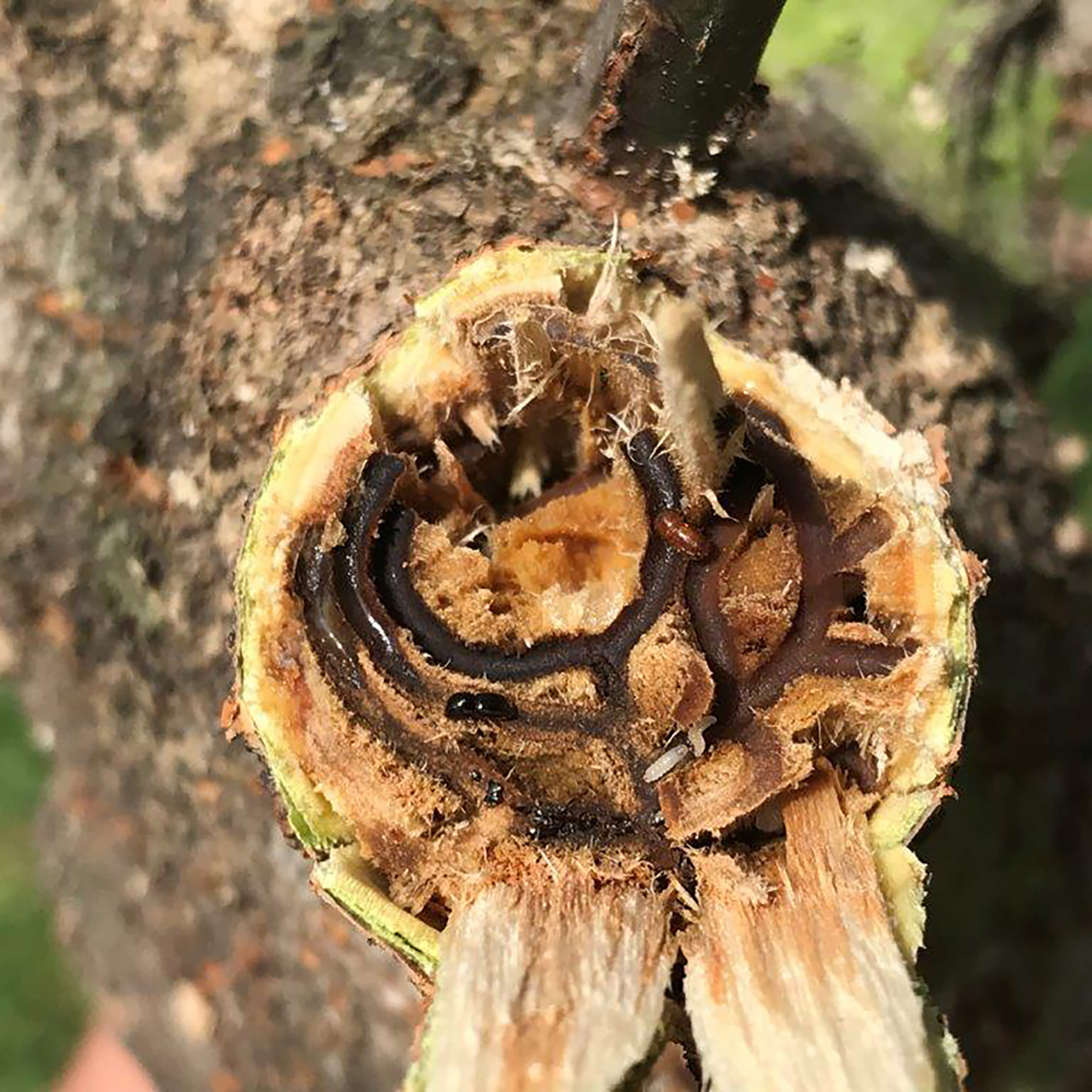
The polyphagous shot hole borer is an invasive insect that is devastating to vegetation in South Africa. (Photo: City of Cape Town)
“Once the beetle is in an area, it cannot be eradicated. We have tested numerous chemical control options and none are effective. Once beetles infest highly susceptible trees, the best and only option is to remove these trees to reduce beetle numbers. Current investigations into biological control are in their infancy and it may take many years to develop a system that can help fight the invasion,” he said.
The Forestry and Agricultural Biotechnology Institute (FABI) at the University of Pretoria has been exploring the possibility of biological controls – introducing natural enemies from the native range of the insect into South Africa – to manage PSHB locally.
On Sunday, 24 March 2024, Professor Brett Hurley and PhD candidate Garyn Townsend from FABI returned from central Vietnam where they collected material from PSHB-infested acacia trees in the hope of identifying and testing natural enemies of the insect that could be used.
It’s a serious problem because it’s got a wide range of hosts, and because there’s no easy or obvious solution for management besides destroying infested materials, which is not always appropriate or feasible.
Hurley said a large amount of PSHB-infested acacia was brought back to the FABI quarantine facility, after obtaining the required permits from both South Africa and Vietnam. This will now be monitored for the presence of PSHB natural enemies (parasitoids).
In an interview with Daily Maverick, Hurley said they focused on going to the beetle’s native range in South East Asia to identify what controls its population in its natural environment. The detection of a natural enemy would then be followed by research to determine whether it would be safe to release in South Africa, and would not, for example, attack native insects.
“This will likely take many years of research and now we are at the exploration phase to see if there is something in the native range that would be safe to use in South Africa. This was our second trip; last year we went to Northern Vietnam,” he said.
Hurley said the PSHB beetle has spread throughout the country and affected valuable individual trees, such as in residential areas and cities, thereby also changing the suburbs and their tree areas, as well as attacking trees in native forests and affecting certain agriculture crops such as pears.
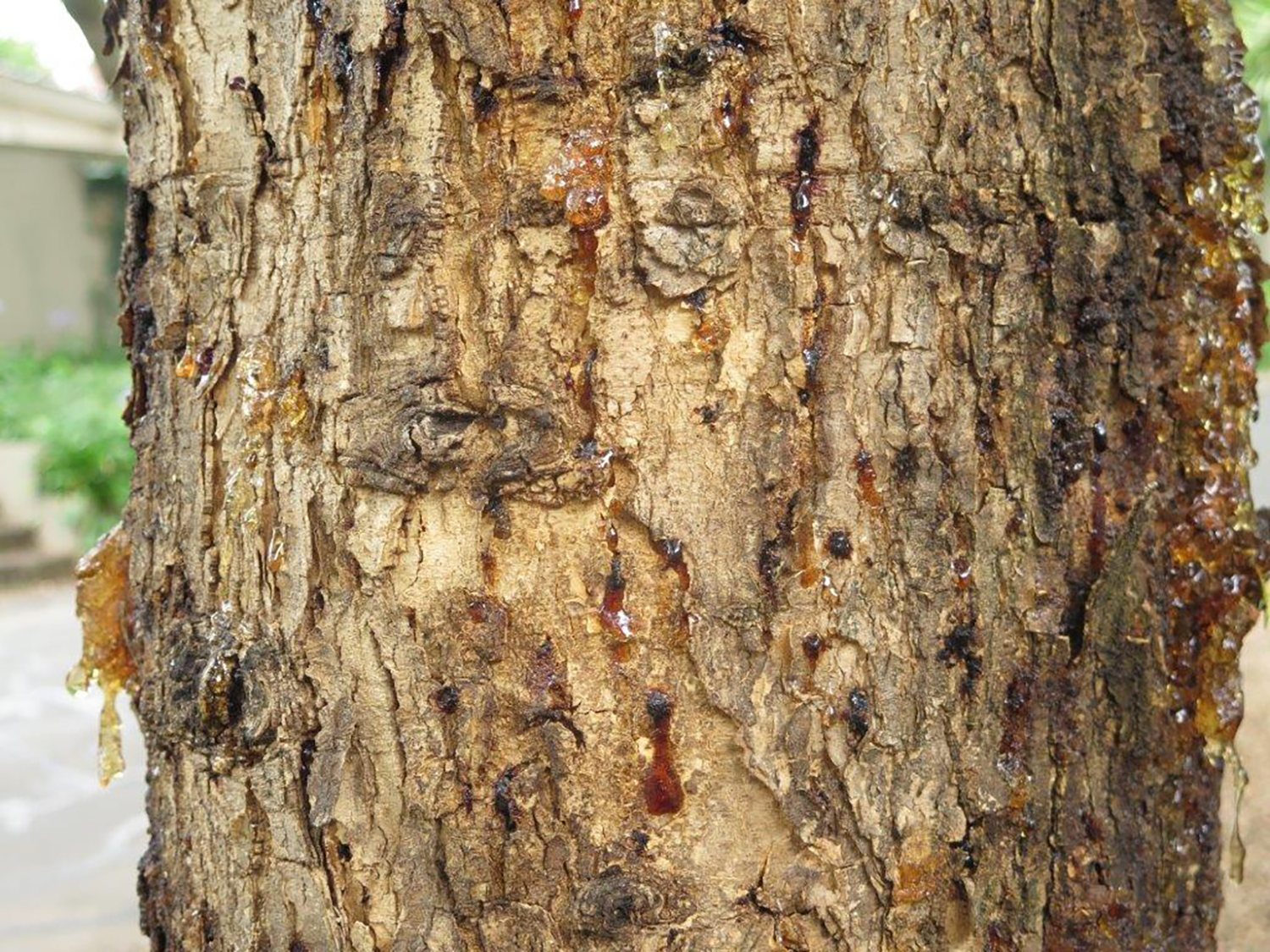
The invasive PSHB beetle was introduced into South Africa from South East Asia in the 2000s. It has no natural enemies here and is accompanied by a fungus that disturbs the functioning of infected trees, eventually killing them. (Photo: City of Cape Town)
“It’s a serious problem because it’s got a wide range of hosts, and because there’s no easy or obvious solution for management besides destroying infested materials, which is not always an appropriate or feasible approach,” Hurley said.
Hurley told Daily Maverick that the potential impact was substantial and there are still a multitude of risks that have not been realised yet – particularly for agricultural crops.
“The urban forestry problem at the moment is probably the biggest issue, in cities, on streets, and in people’s gardens… and agricultural crops as well, especially in the Cape. But it might start attacking other tree species and crops. For example, we have a project at the moment working on pecans and originally [PSHB] didn’t seem to have a big effect on pecans, but now we’re starting to notice the whole situation starting to change and it is actually reproducing on pecan nut trees.”
Read more in Daily Maverick: Three years on, the shot-hole borer continues to eat away at SA’s trees
This showed how the PSHB beetle was evolving and would continue to be difficult to predict if other trees became hosts for the insect, making it essential that the country learnt how to manage it.
“One of the big issues is [that] because it’s not strictly an agricultural pest or strictly in native forests, it’s slipped between the cracks of which department is responsible and where the funding comes from. That delayed a lot of action from government… DFFE provided this funding [for the current exploration of biological control] a few years ago, and we’re just using the leftover funds at the moment for the project. But we don’t have any renewed funds for the project.”
Where are PSHB infestations present in South Africa?
Roets said infestations are known in many major cities including Durban, Richards Bay, Knysna, George, Bloemfontein, Johannesburg, Pretoria, Grahamstown, Stellenbosch and Paarl.
In Cape Town and surrounds it had been first reported in 2019 in Somerset West, after which it spread to Stellenbosch in 2022 and the southern suburbs in 2022/23. This year it had also been found in Paarl.
“South Africa currently has the largest infestation in the world. The infestations are not escalating, rather it is steadily spreading throughout the country and gets noticed only when it arrives in a new area and trees start dying,” Roets said.
Infestations have been found in almost all nine provinces. FABI keeps an updated host list and national distribution of PSHB. Find it here.
More than 5,000 trees infested in Cape Town
Cape Town deputy mayor and the mayoral committee member for spatial planning and environment, Eddie Andrews, said 5,243 trees have been infested across Cape Town – 4,961 of which have been sighted in the Helderberg area since 2019.
Andrews said it would be difficult to give an exact number of trees that have died. However, according to City records, they have removed 2,470 so far.
“The PSHB poses a serious threat to our urban forest, and at this point all of our efforts are aimed at limiting the spread of the pest as best we can. This requires a concerted effort from all of us – from landowners in Cape Town, all of those who work with plant material (gardeners, landscapers, garden services companies, etc), and all spheres of government,” he said.
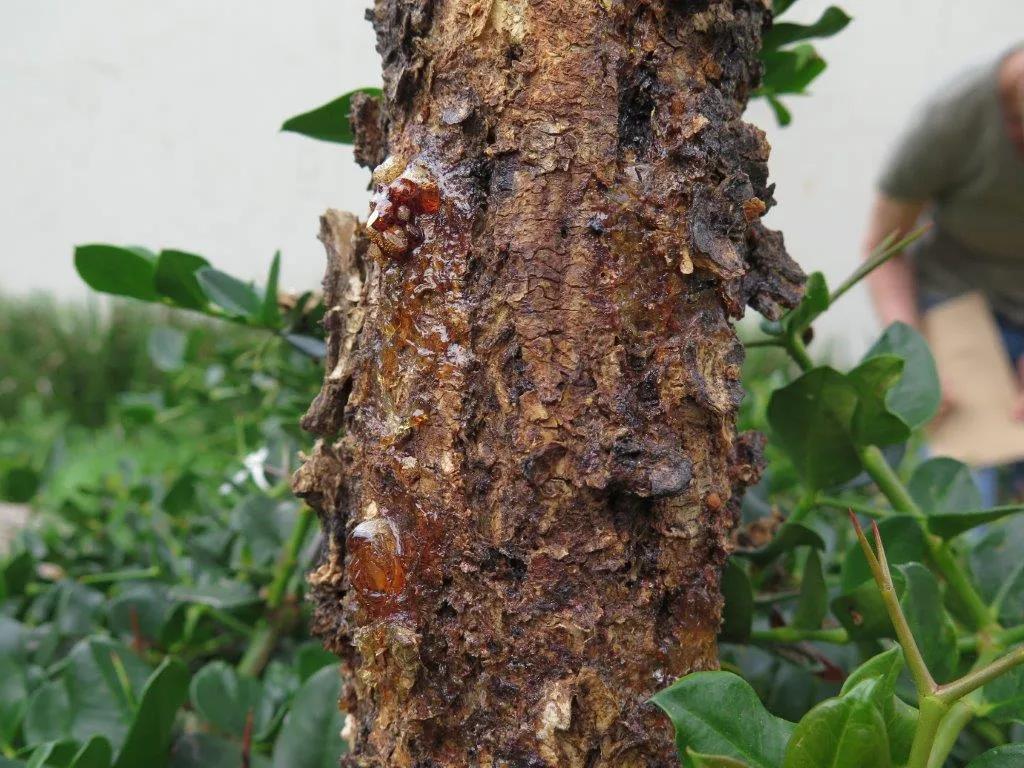
The PSHB beetle is present in several urban areas in South Africa, and has started spreading in Southern Cape forests. (Photo: City of Cape Town)
The major challenge in dealing with the crisis is that there are no known remedies to deal with/eradicate this pest, other than chipping infested trees. Andrews said this was a huge undertaking, with trees weighing several tonnes.
Getting rid of infested/chipped wood was also a challenge because, Andrews said, it must be placed in refuse bags, sealed and put in direct sunlight for at least six weeks in summer and six months in winter. The transport of firewood from areas with infested trees was another huge problem, as well as the use of unclean horticultural equipment.
“Importantly, the use of pesticides and fungicides have not proven effective at eradicating PSHB from infected trees. The PSHB beetle can easily spread across suburbs if extra precaution is not taken,” Andrews said.
“There will be impacts on shading, carbon dioxide sequestration, stormwater runoff and even ecosystem services. However, further research will be required to determine what that full impact will be.”
The City was continuously offering free PSHB training sessions to residents and professionals/small businesses in the garden industry that covered the spread of the pest, symptoms to look out for, and how to handle infested plant material.
“It is crucial that other spheres of government also take the lead in terms of their roles and responsibilities. For example, to date, the national government has not declared the PSHB an invasive species. Without this declaration, the national government does not need to provide funding to provinces and cities to fight the pest,” he said.
Citizen scientists monitoring the infestation
Researchers from SU’s School for Climate Studies have been monitoring the spread of invasion largely using citizen science and climate modelling. In doing so they can understand where the beetle will move to and what its impact will be in South Africa.
Francois Krige, an arborist of more than 30 years and chairperson of Friends of the Arderne Gardens, told Daily Maverick that a number of susceptible species in Cape Town were in the southern suburbs.
“The most challenging aspect is realising that you’re going to have to cut down thousands of your favourite trees. I have a deep love for two of the most susceptible species: European oak and plane. There are trees that I’ve looked after for over 30 years in Cape Town and these are the trees that I’m going to have to cut down. For me, that is the worst part of this,” he said.
Krige said the job of an arborist was the preservation and maintenance of urban trees, he believed that the only way to remain positive throughout the PSHB beetle infestation was to plant more trees than the many thousands that have had to be removed and those that will need to be.
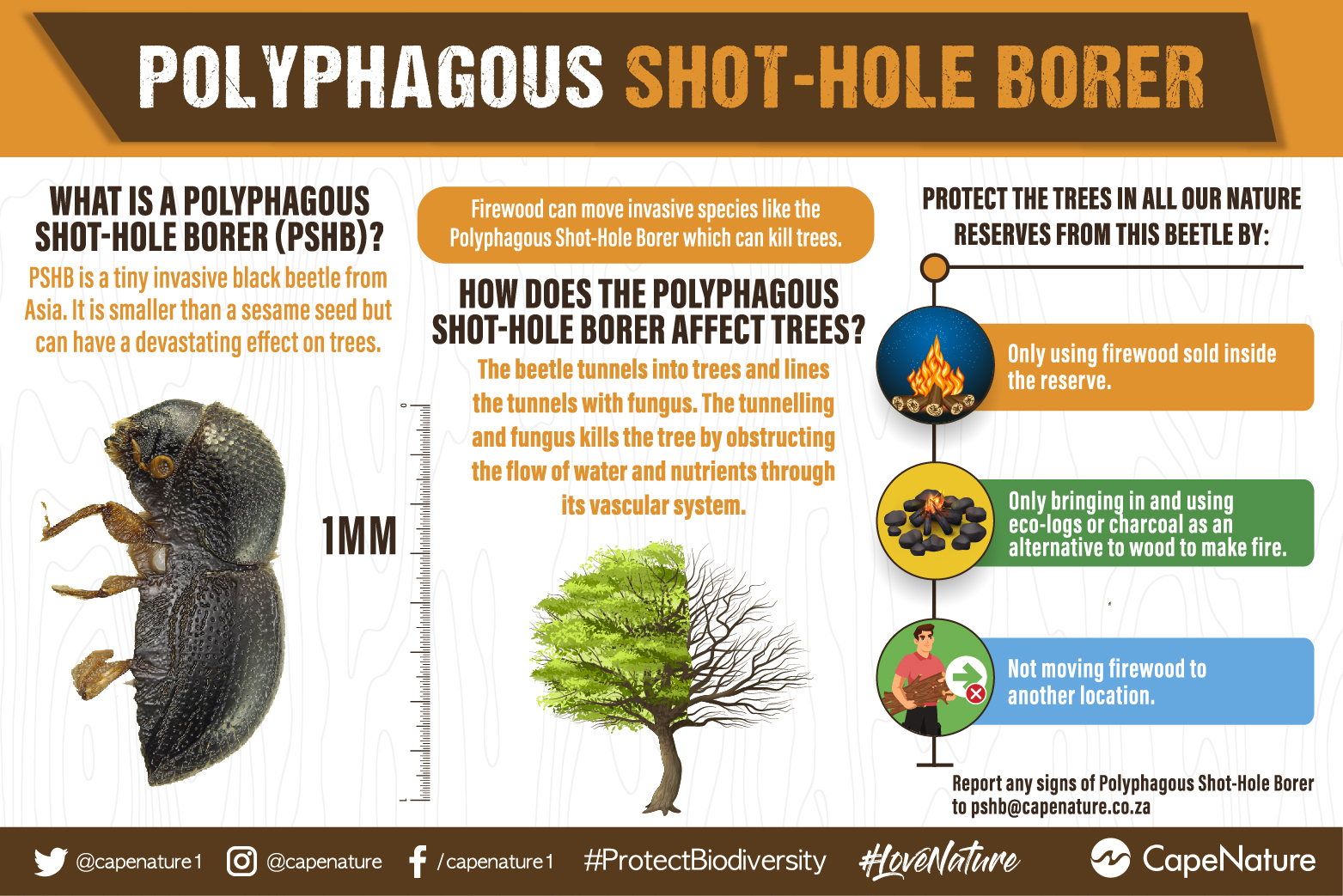
(Graphic: CapeNature.)
“We have the choice of being remembered as the generation who cut down the most beautiful trees, or we can be remembered as the generation who replaced the most beautiful trees. Those are our options, we don’t have much of a middle road here,” he said.
In the Arderne Gardens, Krige said, although it was surrounded by the infestation, none of their trees had succumbed because they had done a lot to avoid it, but the iconic wedding tree (a Moreton Bay fig, one of the largest trees in the country) was still a susceptible species and the PSHB beetle was still a huge threat to the garden.
To combat this threat they had taken several proactive measures – from extensive plant health programmes (feeding and building up soil health) to monitoring trees for any signs of PSHB so they could have as much data as possible.
“We also use pheromones for the beetle, to attract them and lead them into traps… These are very labour-intensive and expensive treatments, not applicable on a small scale, but when you have an area of four hectares it can work.”
Paul Barker, head gardener for the Friends of the Arderne Gardens – an arboretum, public park and provincial heritage site – has been spearheading the PSHB Update Group and the role of citizen scientists in monitoring the infestation.
Barker told Daily Maverick this was a citizen science initiative informing the public about the beetle and its distribution, and mobilising the public to monitor PSHB and lessen the risk to surrounding trees. DM



















 Become an Insider
Become an Insider
We lost a few trees to this little bugger! If it’s from a warm Vietnam, then hopefully a very cold winter would end its prevalence… if we get one?
There is very little that can be done to stop this beetle, as with most alien invader species. The only way to stop alien invasive species is to prevent them from entering in the first place. We must come to terms with the idea that many of our cities and towns (e.g. Somerset West, Stellenbosch) are going to look very different in the next few years, and brace ourselves for the impact of fewer trees, while at the same time doing our best to prevent this from happening again.
There is very little that can be done to stop this beetle, as with most alien invader species. The only way to stop alien invasive species is to prevent them from entering in the first place. We must come to terms with the idea that many of our cities and towns (e.g. Somerset West, Stellenbosch) are going to look very different in the next few years, and brace ourselves for the impact of fewer trees, while at the same time doing our best to prevent this from happening again.
Alien invaders come in the form of other species, not just humans. The African National Corruption party in part has created this fiasco. They lost control of our border crossings and ports to corruption and mismanagement. Now Chinese Triads, the Russian SuperMafia and local gangs control these vital institutions. And aided by the corruption at the Dept of Home Affairs, together with lax oversight at quarantine facilities, this is what you get as a result.
These idiots don’t see scientific backed quarantine measures as necessary, it’s just a hinderence to their looting.
And it’s only going to get worse if the new Environmental megafauna Bill comes into effect. Witch doctors trampling into reserves for bark, leaves, and tubors for muti, with no supervision, will only enable these beetles to spread further.
Sadly it seems that making Charcoal is the only solution to getting rid of the infected tree and its beetle occupants!